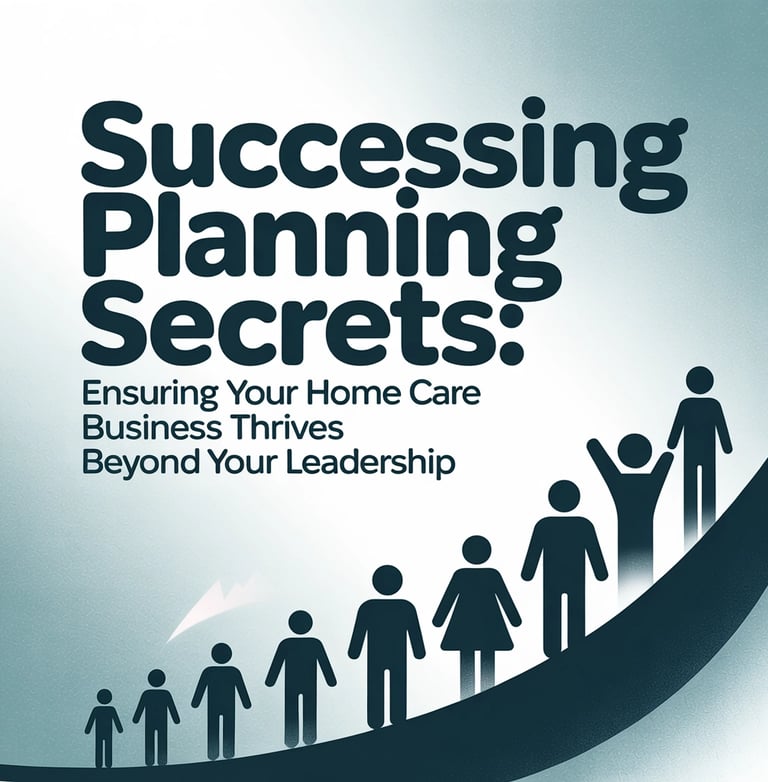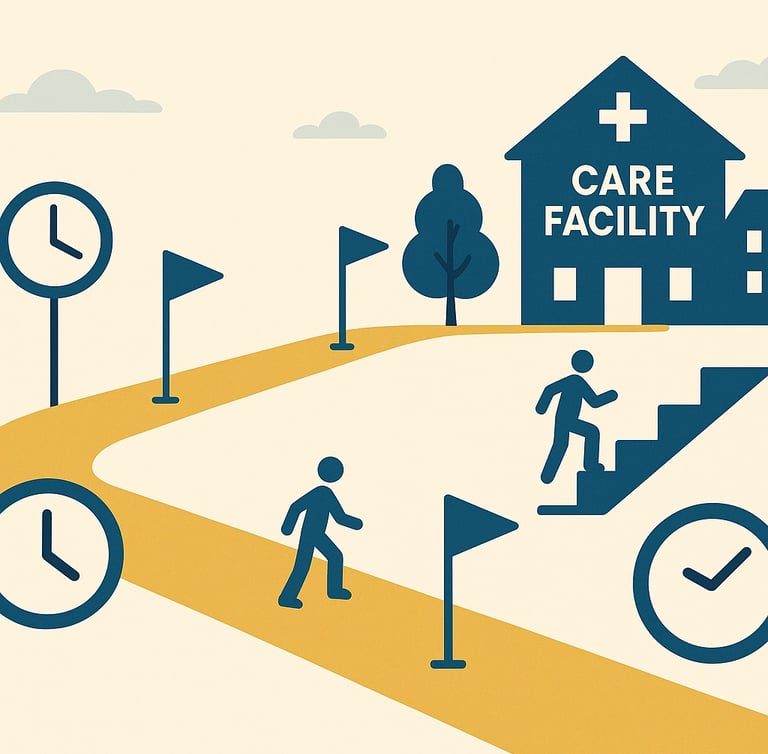Succession Planning Secrets: Ensuring Your Home Care Business Thrives Beyond Your Leadership
Discover the critical steps and inside strategies for succession planning in home care. This blog reveals how home healthcare leaders can seamlessly transition their agencies to new ownership or management while ensuring continuity of care, protecting business value, and safeguarding their legacy. Packed with actionable insights and clickable resources, this post is essential reading for owners ready to future-proof their business beyond their own leadership.
8/25/20256 min read


Why Succession Planning Matters in Home Care
If you’re a home care agency owner, succession planning might seem like a problem for “future you.” But in this industry, the quality of care and the wellbeing of your team depend on smooth leadership transitions. You’ve built something important. Now, it’s time to ensure it thrives after your leadership chapter ends.
Many home care agency owners feel a personal connection to their company’s mission. For some, their home care business is their legacy. For others, it is one of the most valuable assets in the family. Either way, not planning for succession puts your agency and the care outcomes of your clients at risk. In fact, every business owner eventually leaves their business, by choice or by circumstance such as retirement, disability, or other events. Getting ahead of that makes all the difference (JM Search).


Understanding Succession Options
There are several ways to approach succession planning for your home care agency, and the “best” route depends on your goals. Here are the four most common strategies:
1. Passing the Company to a Family Member
This is popular in closely held businesses. It enables family continuity and preserves legacy, but only works well if the next generation is trained and genuinely committed. Good communication and early involvement are key here (Caring Franchise).
2. Transferring Ownership to a Key Employee
Maybe you have a right-hand clinical manager or an operations director who’s been by your side for years. This option rewards loyalty and keeps institutional knowledge in-house. Make sure your successor receives leadership coaching and the transition is gradual, not abrupt.
3. Leaving the Business to a Co-Owner or Business Partner
Some home care agencies have a multi-owner structure. Having a clear buy-sell agreement and documenting leadership responsibilities in advance can prevent costly disagreements down the road (LinkedIn).
4. Selling to an Outside Buyer or Competitor
If you prefer a clean break or want to maximize the value of your business, selling outright might be the answer. This approach requires rigorous preparation, transparency, and attention to valuation. Many agency owners explore partnership programs or professional healthcare M&A consultation for guidance on attractive exit terms (Senate Healthcare).
Some owners opt to retain business ownership but appoint new leadership. While this lets you keep drawing income, it can be difficult to achieve true separation from day-to-day operations, so make sure you are crystal clear about everyone’s roles, decision-making power, and responsibilities (Vitable Health).


When to Start: Succession Planning Timeline
The best time to map out your succession plan is long before you need it. Experts recommend starting a few years ahead of your desired exit date (Caring Franchise) (AIHR). That way, you can nurture your business into one that thrives not just with you at the helm, but with a range of leaders who understand the mission and culture. (Forbes).
Think about these planning questions as you work through the timeline:
Who are the “irreplaceables” on your team now?
What will your company look like in five years? Ten years?
What are your hopes (and your fears) for the company without you?
Where do you want your family or business partners involved?
Running regular check-ins keeps your plan on track and allows you to update documentation as roles, goals, and regulations evolve (McKnight’s Home Care).
Building a Succession Framework
Identify Critical Roles
Every home care business runs on a specific set of roles. A strategic succession plan begins by identifying—not just the owner and CEO, but the essential jobs that drive results. For example: clinical director, operations manager, client relations specialist, and billing lead (LinkedIn).
For each, document:
Responsibilities
Essential skills
Required certifications
Who might fill the role in the future
Develop Successor Talent
Succession isn’t about naming a replacement. It’s about preparing people for leadership. Adopt a culture of mentorship, create on-the-job learning pathways, and offer leadership development for current and future managers. Agency owners who invest in their people tend to have smoother transitions, with less disruption for clients and staff (Learn2Care) (AIHR).


Build skills across different levels, from care coordinators to scheduling supervisors. Empowering talent at all stages ensures operational resilience and reduces leadership bottlenecks.
Codify Mission, Values, and Vision
Your home care agency is more than just a service—it’s a set of values and promises upheld by leadership and staff. During planning, articulate your vision in a written document, share stories that define your company culture, and show why your mission matters.
This is especially vital for family-owned agencies or businesses with a legacy in the community. It keeps the spirit of your organization alive, even as roles evolve (JM Search).
Home Care-Specific Succession Challenges
Succession planning in healthcare isn’t just about continuity—it’s about compliance, licensure, quality measures, and relationships with staff and families.
Unlike many industries, home care agencies need licensed staff, regulatory compliance systems, and seamless client service. Leadership changes are more complex. If your Clinical Supervisor, for example, isn’t ready to step up, regulatory approval could be delayed or surveys may have negative findings.
To avoid pitfalls:
Maintain a clear training plan for licensed positions.
Document policies and regulatory compliance processes.
Communicate with key referral partners about transitions.
Use strategies like phased handover and dual-role shadowing.
Continuity in care is everything. Families and staff trust your agency’s reputation. Any planned leadership changes should always be communicated clearly, with a focus on the benefits for clients and team members (Home Health Care News).


Metrics for Succession Success
A strong succession plan isn’t a one-and-done document. Gauge your plan’s effectiveness by monitoring:
Talent retention rates at all levels
Employee feedback and readiness surveys
Client satisfaction data after leadership changes
Regulatory compliance scores post-transition
If you see dips in these numbers after a change, circle back and adjust your plan. Regular reviews keep you ahead of potential issues and alert you to training or mentorship gaps (Vitable Health) (AIHR).
Avoiding Common Pitfalls
Far too many businesses fail after transition because the successor wasn’t truly prepared or the team didn’t buy into the new leader’s vision. Pitfalls often include:
Rushed timelines; handovers that happen too quickly or during a crisis
Lack of skill development in key roles
Not documenting processes, leading to knowledge loss
Poor communication with staff or referral sources
Ignoring updates based on regulation or technology
Business owners who involve all stakeholders, prepare far in advance, and build supportive teams are the ones whose companies thrive for years to come (Senate Healthcare).
Tools and Outside Support
Succession planning can be a complex puzzle—especially if you are navigating family expectations, regulatory challenges, or want to maximize the value if you sell. Many home care agency owners work with advisors, accountants, or specialized succession planning consultants to get it right (Senate Healthcare).
Resources like the Senate Healthcare Succession Planning Toolkit and Home Care Partnerships Consultation can connect agency owners to expert support, current market benchmarks, and transition strategies.
Regularly reviewing your plan with outside eyes is incredibly valuable, ensuring nothing slips through the cracks.
Conclusion
Succession is about more than handing over the keys—it’s about preparing people, preserving your mission, and ensuring ongoing care for those who depend on your agency. Take action early, involve your leadership team, and review your plan regularly. With the right framework and mindset, your home care business can flourish for generations, no matter who is at the wheel.
References
JM Search: The Top 4 Trends Affecting the Home Health Care Industry in 2025
AIHR 11: Succession Planning Best Practices to Follow in 2025
McKnight’s Home Care: 9 Workforce Trends to Focus On in 2025
Learn2Care: How Generative AI is Revolutionizing Home Care & Caregiver Training
Caring Franchise: 11 Effective Recruitment Strategies for Hiring Caregivers
Vitable Health: 2025 Home Care Staffing & Retention Strategy Guide
Forbes: Strategizing And Flexibility: Keys To Health Care Succession Planning
LinkedIn: The Healthcare Staffing Landscape in the U.S. in 2025
Senate Healthcare: Succession Planning in the Age of AI: Protecting Your Legacy and Business Value
Senate Healthcare: What Makes a Home Care Agency an Attractive Acquisition Target in 2025?
Senate Healthcare: Succession Planning as a Strategic Advantage
Unlock Your 30-Minute Agency Succession Review
Maybe you're ready to expand your reach, or perhaps it's time to consider your legacy and the future of your business. Either way, it all begins with a conversation. Schedule a confidential, no-obligation call to explore what the future might hold for you and your business.
Complete the form, and we'll reach out for a chat...


© 2025 SENATE HEALTHCARE LLC.
ALL RIGHTS RESERVED


